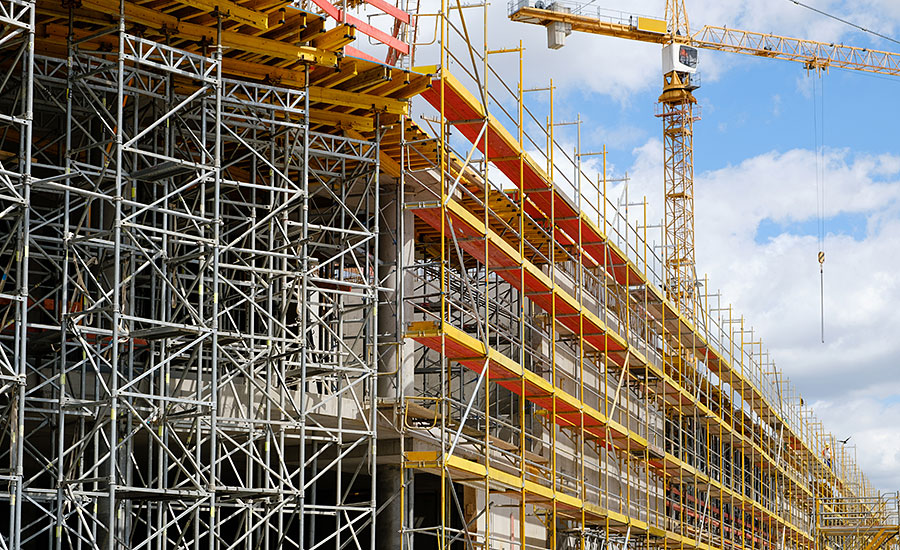Temporary Roof Scaffolding for Your Construction or Renovation Project
Temporary Roof Scaffolding for Your Construction or Renovation Project
Blog Article
The Perks of Scaffolding for Safety And Security and Efficiency in Building Projects
Scaffolding is a crucial part in the realm of construction, significantly contributing to both security and operational effectiveness. The influence of scaffolding prolongs beyond standard security measures; its critical application can change task timelines and results (Scaffolding).
Boosted Employee Safety And Security

Boosted employee security is an extremely important concern in the construction sector, where the dangers associated with drops and crashes can have alarming effects. Effective scaffolding systems play a vital function in alleviating these dangers by providing steady systems for workers at raised heights. By making certain that scaffolding is correctly set up and maintained, construction firms can significantly reduce the probability of falls, which are among the leading reasons for office injuries and casualties.
Additionally, scaffolding improves safety through its layout attributes. Guardrails, toe boards, and non-slip surfaces contribute to a secure workplace, lessening the risk of crashes. In addition, scaffolding permits workers to accessibility hard-to-reach areas without the requirement for makeshift remedies, which can compromise safety criteria.
Educating workers on the proper use scaffolding is similarly essential. Making sure that workers are educated about tons abilities, setting up treatments, and safety procedures better improves the efficiency of scaffolding in stopping mishaps. Finally, including durable scaffolding systems within building tasks not only boosts worker security yet likewise advertises a society of security that benefits the whole labor force while boosting general efficiency.
Improved Gain Access To and Wheelchair

In addition, scaffolding permits for the convenient transportation of tools and products, decreasing downtime associated with relocating equipment. Workers can effectively access different areas of a job, which is particularly essential in intricate builds where upright and horizontal activity is frequent - Scaffolding. This ease of access not just improves procedures but also enables groups to react rapidly to changing job needs
In addition, scaffolding can be tailored to fit particular website problems, boosting mobility in limited or irregular spaces. This versatility guarantees that construction activities can continue smoothly, regardless of the obstacles provided by the atmosphere. By fostering better accessibility and wheelchair, scaffolding plays a critical duty in supporting construction teams and maximizing the total effectiveness of structure projects.
Boosted Task Effectiveness
In building and construction, job efficiency is considerably influenced by the effective use of scaffolding systems. By providing a stable and secure system for employees, scaffolding lessens downtime and speeds up the pace of building and construction activities. With improved access to elevated workplace, groups can complete tasks quicker, minimizing the overall job timeline.
The modular nature of modern-day scaffolding permits rapid setting up and disassembly, allowing speedy shifts between different stages of a task. This flexibility not just enhances operations yet likewise adds to much better coordination amongst various trades, as multiple groups can work concurrently on different areas of a structure.
Additionally, scaffolding makes certain that workers are positioned correctly to execute their tasks without unneeded stress or risk of injury, thereby minimizing the possibility of crashes that can result in pricey delays. Boosted precaution embedded in scaffolding systems, such as guardrails and toe boards, further assistance effective procedures by keeping worker emphasis on the job at hand rather than safety and security worries.

Convenience for Numerous Projects
Scaffolding systems stick out for their adaptability across a large range of building and construction projects, capable of conference specific site demands and jobs. Their modular style permits for fast changes to fit numerous building types, from household to commercial frameworks, guaranteeing that workers have secure accessibility at different heights and angles.
These systems can be tailored for varied applications, such as façade work, indoor restorations, or sturdy industrial projects. As an example, light-weight aluminum scaffolds are suitable for interior work, while robust steel frameworks provide the required support for large building. The convenience of scaffolding reaches its capacity to be set up for both momentary and irreversible structures, allowing specialists to efficiently prepare and execute their projects.
In addition, scaffolding can be utilized in tough atmospheres, including city setups where space is minimal or scaffolding technique on unequal terrain where typical gain access to remedies are impractical. This adaptability minimizes the need for multiple access solutions, reducing expenses and job timelines. By suiting a selection of jobs and problems, scaffolding boosts the overall efficiency and effectiveness of building initiatives, showing to be an essential property in the building sector.
Conformity With Security Standards
Exactly how can building jobs guarantee the safety of employees while preserving efficiency? Compliance with safety and security standards is paramount in accomplishing this balance. Governing frameworks, such as OSHA in the United States, supply guidelines that govern making use of scaffolding, making sure that it fulfills rigid safety and security check my blog standards. By sticking to these standards, building companies can reduce the risk of accidents, which not just secures workers but additionally enhances overall project efficiency.
Proper scaffolding design and setup play a vital function in compliance. Educating workers on safe scaffold use and the importance of conformity with safety criteria even more reinforces a culture of safety and security on-site.
Furthermore, documentation and record-keeping relevant to safety examinations and worker training are essential. These practices not just demonstrate conformity but likewise provide liability and openness. Ultimately, by focusing on adherence to safety and security standards, building and construction projects can promote a safer workplace, consequently increasing efficiency and effectiveness without endangering worker safety.
Conclusion
In verdict, scaffolding acts as an essential component in building projects, substantially improving safety and security and performance. Its layout attributes, including guardrails and non-slip surface areas, add to a more secure working setting while promoting better accessibility and mobility for employees. The modular nature of scaffolding promotes fast setting up, therefore raising overall job performance. Additionally, adherence to safety and security standards highlights the relevance of scaffolding in achieving successful job end results, making it important in the building and construction sector.
Scaffolding is a vital element in the realm of building, substantially adding to both safety and operational effectiveness. The influence of scaffolding expands beyond basic security steps; its tactical implementation can change project timelines and end results. In final thought, incorporating robust scaffolding systems within building projects not only boosts employee security however also advertises a society of security that benefits the whole labor force while improving overall productivity.
In verdict, scaffolding offers as an important component in structure jobs, considerably enhancing safety and security and effectiveness. here are the findings Adherence to security standards emphasizes the value of scaffolding in achieving effective job outcomes, making it crucial in the building and construction industry.
Report this page